Effect of Sewage Sludge Addition on the Co-Combustion Characteristics of Municipal Solid Waste Incineration
Abstract
:1. Introduction
2. Materials and Methods
2.1. Numerical Simulation Method
- (1)
- The inlet of the model is set as a closed adiabatic wall to isolate the influence of the external environment on the combustion process.
- (2)
- Gravity acceleration is set to 9.81 m/s2 to simulate the influence of the Earth’s gravity field on the combustion process.
- (3)
- The primary air inlet of the incinerator is assumed to be a fluid feed inlet for introducing a mixture of fuel and air. The wall temperature of the incinerator was set to 800 K, representing the furnace combustion temperature, and simulated the initial thermal state within the furnace.
- (4)
- The secondary air inlet of the incinerator is set as the inlet vent to provide additional air required for combustion and ensure the completion of the combustion process.
- (5)
- The furnace height is based on the actual incinerator design to ensure the accuracy of the simulation results.
- (6)
- The flue outlet of the MSW incinerator is set as the outflow boundary to simulate the exhaust process of the flue gas generated by combustion. The return flue gas temperature is set to 800 K to simulate the circulation and heat exchange of the flue gas in the furnace.
- (7)
- The slag discharge port is also set as a closed adiabatic wall to prevent heat loss and the ingress of impurities.
- (8)
- The incineration products of MSW and SS are simplified to CO2, O2, H2, and N2, while gaseous pollutants produced by small amounts of elements such as sulfur and nitrogen are ignored.
2.2. Models and Computational Conditions
2.3. Materials
3. Results and Discussion
3.1. Co-Combustion of SS and MSW at Different Ratios
3.1.1. Temperature Characteristics at Different Ratios
3.1.2. Speed Characteristics at Different Ratios
3.1.3. Component Characteristics at Different Ratios
3.2. MSW Incinerator Temperature
3.2.1. Temperature Characteristics at Different Incinerator Temperature
3.2.2. Speed Characteristics at Different Incinerator Temperature
3.2.3. Component Characteristics at Different Incinerator Temperature
4. Conclusions
Author Contributions
Funding
Data Availability Statement
Conflicts of Interest
References
- Ding, Y.; Zhao, J.; Liu, J.-W.; Zhou, J.; Cheng, L.; Zhao, J.; Shao, Z.; Iris, Ç.; Pan, B.; Li, X. A review of China’s municipal solid waste (MSW) and comparison with international regions: Management and technologies in treatment and resource utilization. J. Clean. Prod. 2021, 293, 126144. [Google Scholar] [CrossRef]
- Kumar, A.; Singh, E.; Mishra, R.; Lo, S.L.; Kumar, S. Global trends in municipal solid waste treatment technologies through the lens of sustainable energy development opportunity. Energy 2023, 275, 127471. [Google Scholar] [CrossRef]
- Jiang, X.; Zhao, Y.; Yan, J. Disposal technology and new progress for dioxins and heavy metals in fly ash from municipal solid waste incineration: A critical review. Environ. Pollut. 2022, 311, 119878. [Google Scholar]
- Xu, J.; Liao, Y.; Yu, Z.; Cai, Z.; Ma, X.; Dai, M.; Fang, S. Co-combustion of paper sludge in a 750 t/d waste incinerator and effect of sludge moisture content: A simulation study. Fuel 2018, 217, 617–625. [Google Scholar] [CrossRef]
- Liang, Y.; Xu, D.; Feng, P.; Hao, B.; Guo, Y.; Wang, S. Municipal sewage sludge incineration and its air pollution control. J. Clean. Prod. 2021, 295, 126456. [Google Scholar] [CrossRef]
- Chen, G.; Wang, X.; Li, J.; Yan, B.; Wang, Y.; Wu, X.; Velichkova, R.; Cheng, Z.; Ma, W. Environmental; energy, and economic analysis of integrated treatment of municipal solid waste and sewage sludge: A case study in China. Sci. Total Environ. 2019, 647, 1433–1443. [Google Scholar] [CrossRef] [PubMed]
- Werther, J.; Ogada, T. Sewage sludge combustion. Prog. Energy Combust. Sci. 1999, 25, 55–116. [Google Scholar] [CrossRef]
- Assi, A.; Bilo, F.; Federici, S.; Zacco, A.; Depero, L.E.; Bontempi, E. Bottom ash derived from municipal solid waste and sewage sludge co-incineration: First results about characterization and reuse. Waste Manag. 2020, 116, 147–156. [Google Scholar] [CrossRef]
- Marganingrum, D.; Hidawati; Djaja, S.D.S. A preliminary study of fuel mixtures of industrial sludge, bottom ash, and municipal solid waste for co-firing in coal boilers. Energy Ecol. Environ. 2022, 7, 186–198. [Google Scholar] [CrossRef]
- Wang, Y.; Liu, Y.; Yang, W.; Zhao, Q.; Dai, Y. Evaluation of combustion properties and pollutant emission characteristics of blends of sewage sludge and biomass. Sci. Total Environ. 2020, 720, 137365. [Google Scholar] [CrossRef] [PubMed]
- Lin, T.; Liao, Y.; Dai, T.; Ma, X. Investigation on co-disposal technology of sludge and municipal solid waste based on numerical simulation. Fuel 2023, 343, 127882. [Google Scholar] [CrossRef]
- Lin, H.; Ma, X. Simulation of co-incineration of sewage sludge with municipal solid waste in a grate furnace incinerator. Waste Manag. 2012, 32, 561–567. [Google Scholar] [CrossRef] [PubMed]
- Stopford, P.J. Recent applications of CFD modelling in the power generation and combustion industries. Appl. Math. Model. 2002, 26, 351–374. [Google Scholar] [CrossRef]
- Costa, M.; Massarotti, N.; Mauro, A.; Arpino, F.; Rocco, V. CFD modelling of a RDF incineration plant. Appl. Therm. Eng. 2016, 101, 710–719. [Google Scholar] [CrossRef]
- Yang, Y.; Ryu, C.; Goodfellow, J.; Sharifi, V.N.; Swithenbank, J. Modelling waste combustion in grate furnaces. Process Saf. Environ. Prot. 2004, 82, 208–222. [Google Scholar] [CrossRef]
- Shaheed, R.; Mohammadian, A.; Gildeh, H.K. A comparison of standard k–ε and realizable k–ε turbulence models in curved and confluent channels. Environ. Fluid Mech. 2019, 19, 543–568. [Google Scholar] [CrossRef]
- Sazhin, S.; Sazhina, E.; Faltsi-Saravelou, O.; Wild, P. The P-1 model for thermal radiation transfer: Advantages and limitations. Fuel 1996, 75, 289–294. [Google Scholar] [CrossRef]
- Qian, X.; Lee, S.; Chandrasekaran, R.; Yang, Y.; Caballes, M.; Alamu, O.; Chen, G. Electricity evaluation and emission characteristics of poultry litter co-combustion process. Appl. Sci. 2019, 9, 4116. [Google Scholar] [CrossRef]
- Linlin, F.; Zifu, S.; Yonggang, Z.; Xiaolong, P.; Mengmei, M.; Sheng, Z.; Fei, W. Study on Numerical Simulation of Large-scale Waste Incineration Grate Furnace Co-incineration with Sludge. Environ. Sanit. Eng. 2020, 28, 32–37. (In Chinese) [Google Scholar]
- Varol, M.; Atimtay, A.T.; Olgun, H.; Atakül, H. Emission characteristics of co-combustion of a low calorie and high sulfur–lignite coal and woodchips in a circulating fluidized bed combustor: Part 1. Effect of excess air ratio. Fuel 2014, 117, 792–800. [Google Scholar] [CrossRef]
- Batistella, L.; Silva, V.; Suzin, R.C.; Virmond, E.; Althoff, C.A.; Moreira, R.F.; José, H.J. Gaseous emissions from sewage sludge combustion in a moving bed combustor. Waste Manag. 2015, 46, 430–439. [Google Scholar] [CrossRef]
- Chen, L.; Liao, Y.; Xia, Y.; Ma, X. Combustion characteristics of co-combusted municipal solid wastes and sewage sludge. Energy Sources Part A Recovery Util. Environ. Eff. 2020, 46, 5730–5742. [Google Scholar] [CrossRef]
- Qian, X.; Xue, J.; Yang, Y.; Lee, S.W. Thermal properties and combustion-related problems prediction of agricultural crop residues. Energies 2021, 14, 4619. [Google Scholar] [CrossRef]
- He, S.; Chen, K.; Zhang, Y.; Cheng, Y.; Liu, S.; Yu, B.; Wang, L.; Wang, X. The coincineration of sewage sludge and municipal solid waste in an industrial scale incineration power plant. Int. J. Environ. Sci. Technol. 2023, 20, 2919–2928. [Google Scholar] [CrossRef]
- Zhou, X.; Zhou, P.; Zhao, X.; Song, Z.; Wang, W.; Sun, J.; Mao, Y. Applicability of municipal solid waste incineration (MSWI) system integrated with pre-drying or torrefaction for flue gas waste heat recovery. Energy 2021, 224, 120157. [Google Scholar] [CrossRef]
- Huang, Z.; Zhu, J.; Wu, X.; Qiu, R.; Xu, Z.; Ruan, J. Eddy current separation can be used in separation of non-ferrous particles from crushed waste printed circuit boards. J. Clean. Prod. 2021, 312, 127755. [Google Scholar] [CrossRef]
- Li, Z.; Fan, T.W.; Lun, M.S.; Li, Q. Optimization of municipal solid waste incineration for low-NOx emissions through numerical simulation. Sci. Rep. 2024, 14, 19309. [Google Scholar] [CrossRef] [PubMed]
- Lee, H.; Yi, S.-M.; Holsen, T.M.; Seo, Y.-S.; Choi, E. Estimation of CO2 emissions from waste incinerators: Comparison of three methods. Waste Manag. 2018, 73, 247–255. [Google Scholar] [CrossRef]
- Tao, J.; Li, Z.; Chen, C.; Liang, R.; Wu, S.; Lin, F.; Cheng, Z.; Yan, B.; Chen, G. Intelligent technologies powering clean incineration of municipal solid waste: A system review. Sci. Total Environ. 2024, 173082. [Google Scholar] [CrossRef]
- Zhuang, J.; Tang, J.; Aljerf, L. Comprehensive review on mechanism analysis and numerical simulation of municipal solid waste incineration process based on mechanical grate. Fuel 2022, 320, 123826. [Google Scholar] [CrossRef]

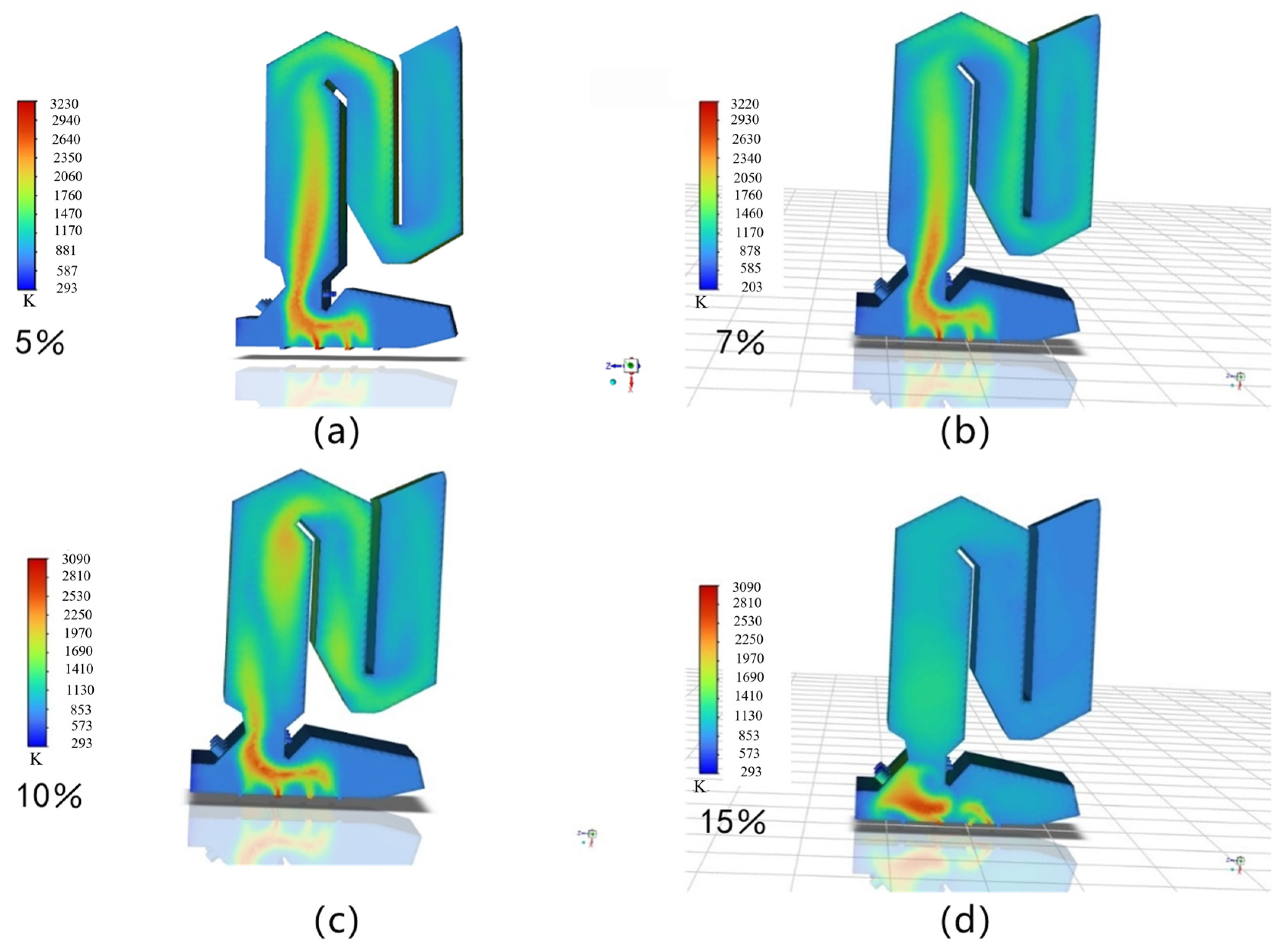

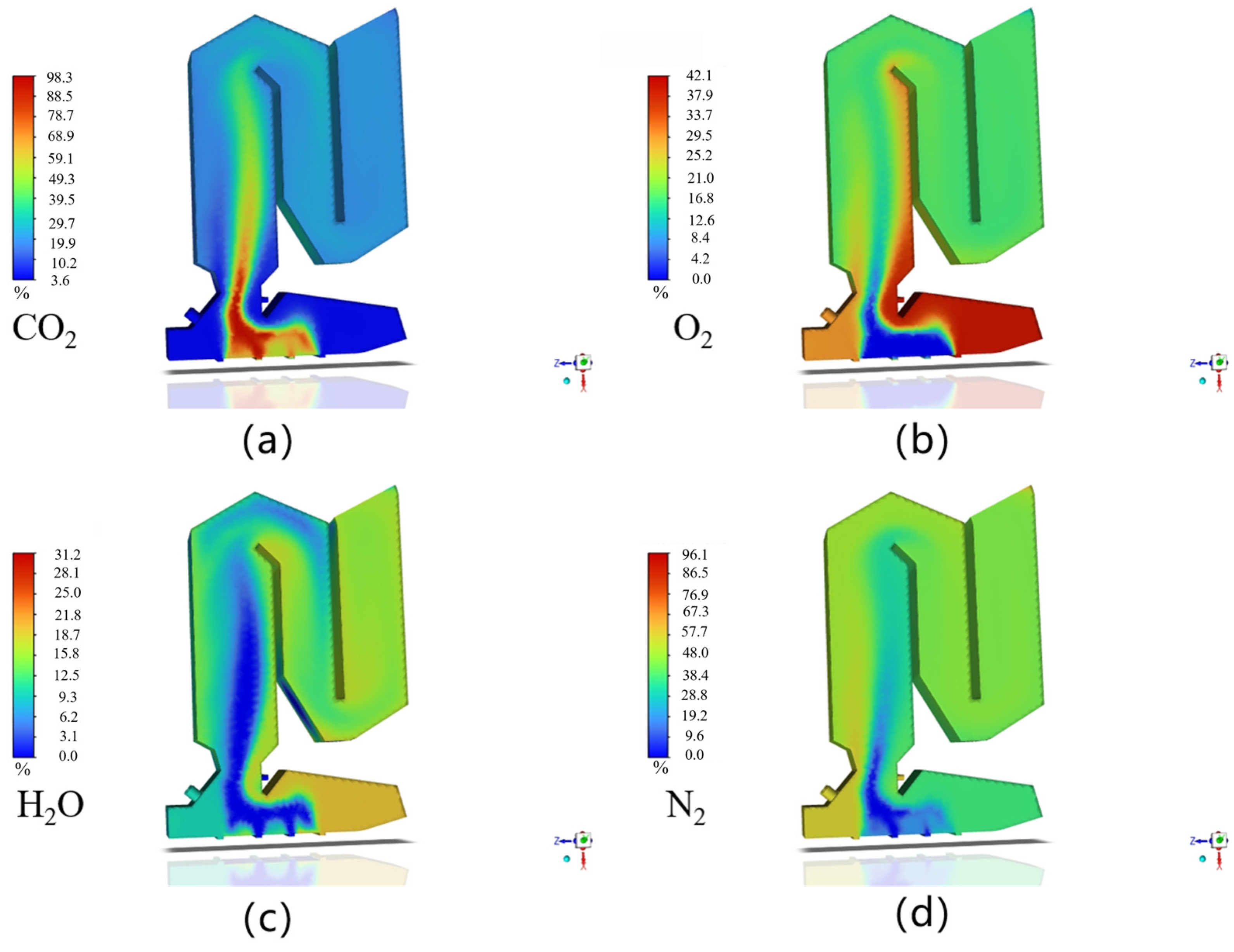

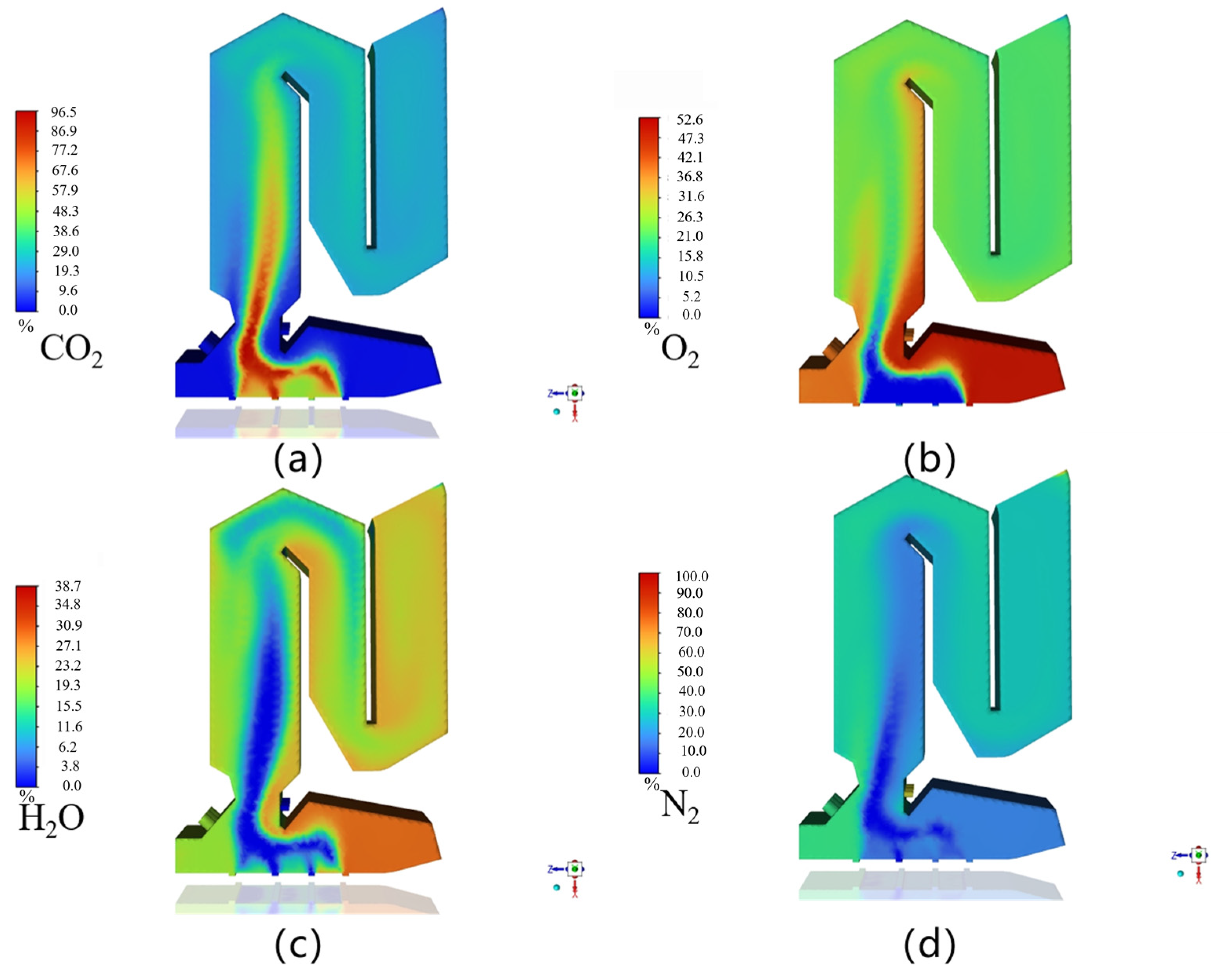
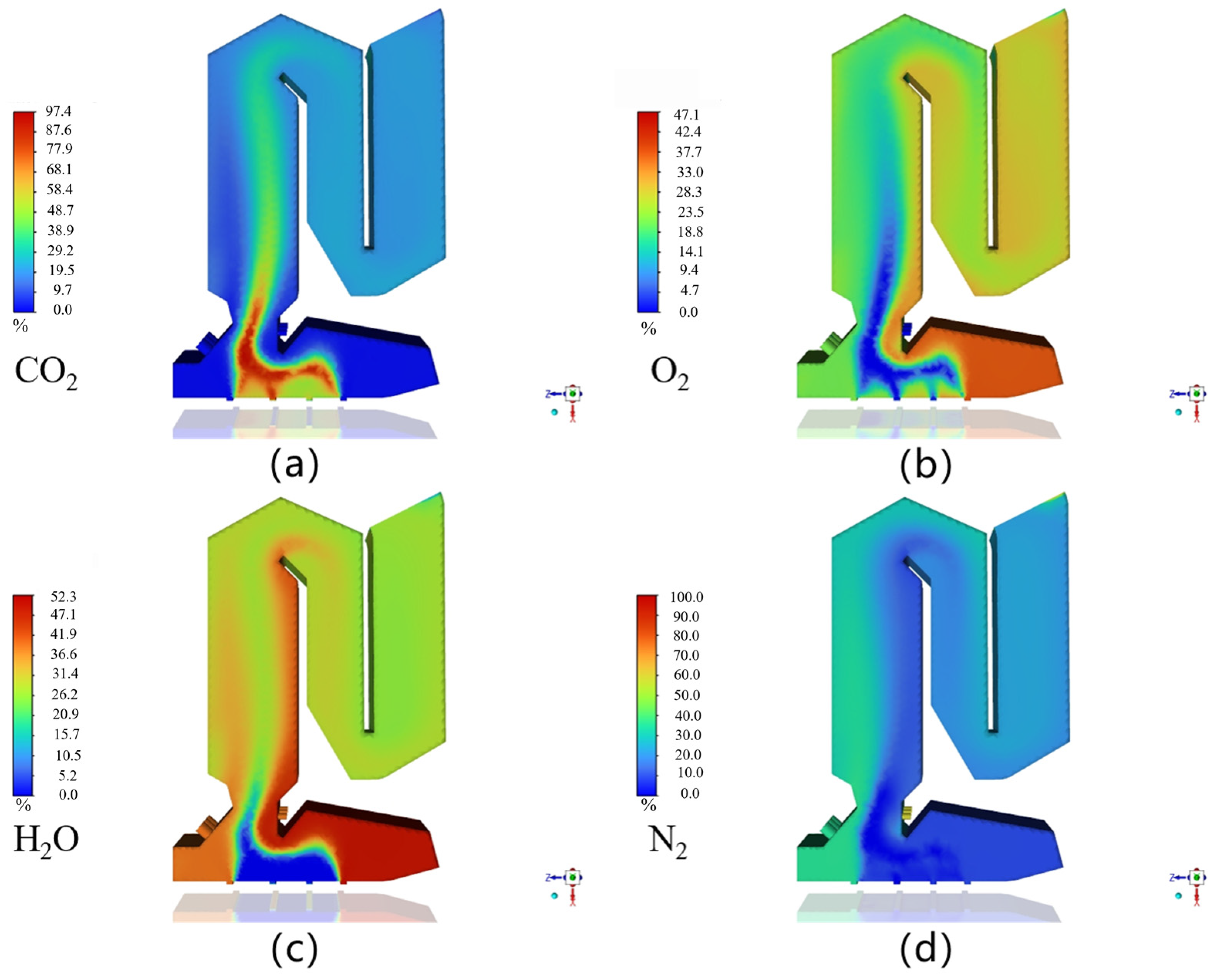


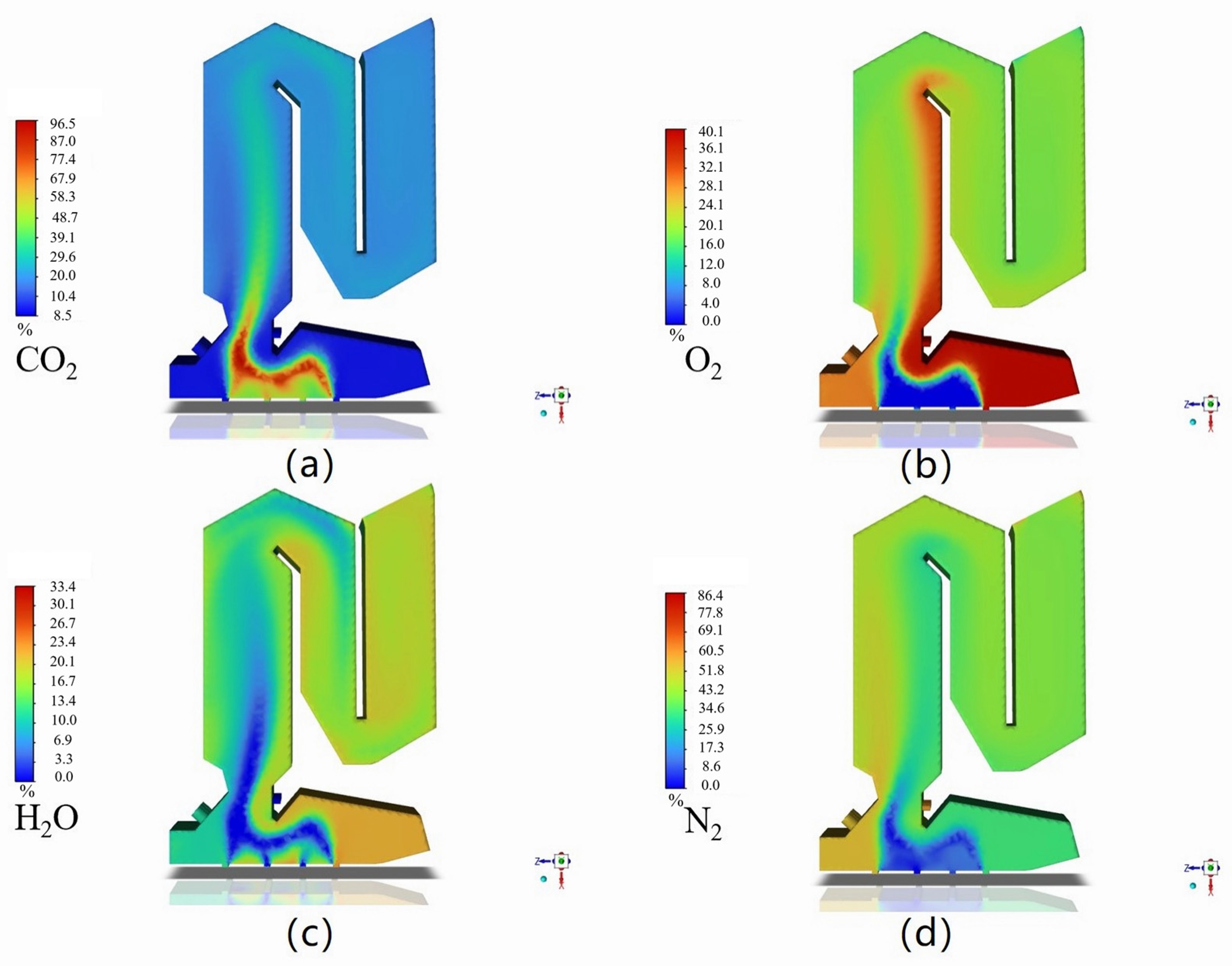

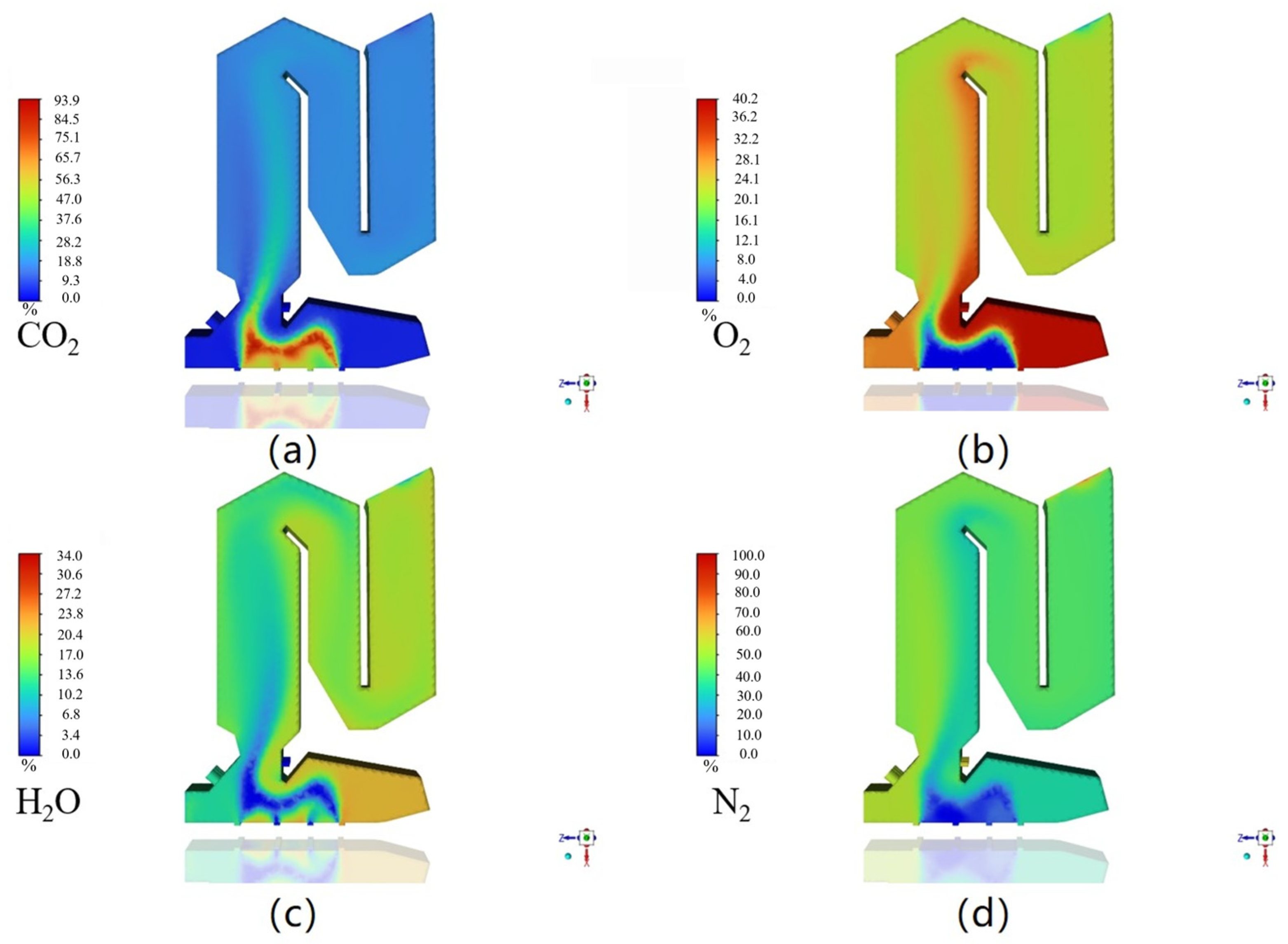
| Samples | Ultimate Analysis (wt%) | Proximate Analysis (wt%) | |||||||
|---|---|---|---|---|---|---|---|---|---|
| C | H | O | N | S | Volatile | Fixed Carbon | Ash | Moisture | |
| MSW | 21.13 | 3.01 | 10.0 | 0.49 | 0.16 | 27 | 8 | 22 | 43 |
| SS | 16.74 | 2.34 | 8.76 | 2.7 | 0.6 | 24.36 | 6.78 | 28.86 | 40 |
| Conditions (%) | CO2 | O2 | H2O | N2 |
|---|---|---|---|---|
| 5% | 19.9 | 16.8 | 9.4 | 48.0 |
| 7% | 20.0 | 20.9 | 9.74 | 43.5 |
| 10% | 38.6 | 21.0 | 15.5 | 30.0 |
| 15% | 38.9 | 23.5 | 31.4 | 20.0 |
Disclaimer/Publisher’s Note: The statements, opinions and data contained in all publications are solely those of the individual author(s) and contributor(s) and not of MDPI and/or the editor(s). MDPI and/or the editor(s) disclaim responsibility for any injury to people or property resulting from any ideas, methods, instructions or products referred to in the content. |
© 2024 by the authors. Licensee MDPI, Basel, Switzerland. This article is an open access article distributed under the terms and conditions of the Creative Commons Attribution (CC BY) license (https://creativecommons.org/licenses/by/4.0/).
Share and Cite
Wu, H.; Zhu, L.; Cai, J.; Lv, H. Effect of Sewage Sludge Addition on the Co-Combustion Characteristics of Municipal Solid Waste Incineration. Processes 2024, 12, 2172. https://doi.org/10.3390/pr12102172
Wu H, Zhu L, Cai J, Lv H. Effect of Sewage Sludge Addition on the Co-Combustion Characteristics of Municipal Solid Waste Incineration. Processes. 2024; 12(10):2172. https://doi.org/10.3390/pr12102172
Chicago/Turabian StyleWu, Hao, Lingxia Zhu, Jianjun Cai, and Huijuan Lv. 2024. "Effect of Sewage Sludge Addition on the Co-Combustion Characteristics of Municipal Solid Waste Incineration" Processes 12, no. 10: 2172. https://doi.org/10.3390/pr12102172






